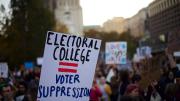How are members of Harvard’s Board of Overseers chosen—and what do they do, once they are elected to the governing board? Those questions, of little general interest to most of the community most of the time, have suddenly become salient because for the second time since 2016, five candidates advocating action on a set of substantive issues have gained a place on the ballot via petition, joining the eight candidates nominated through the University’s formal committee process (read about the complete roster and background here).
Arithmetically, that means that 13 aspirants now seek the five openings on the 30-member board to be filled in this spring’s election, lending a liveliness to the contest. Programmatically and philosophically, it highlights important—and asymmetrical—views about Harvard governance, and the purposes and principles by which the place operates.
The Nominating Committee
As part of its constitution, said Harvard Alumni Association (HAA) executive director Philip Lovejoy in a recent conversation, the HAA has a Committee to Nominate Overseers and Elected Directors (of the association itself). The nominating committee, an HAA standing committee, has 15 members:
- two nonvoting University officials (the Secretary to the Governing Boards—the Overseers and the Corporation; and the vice president for alumni affairs and development); and
- a changing cohort of 13 appointees, serving three-year terms, who include three current or former Overseers, appointed by the president of the Board of Overseers, and 10 alumni, chosen by the HAA executive committee.
The current members are listed here. Lovejoy said that in making its appointments, the executive committee aims for a nominating committee with representation across schools, geographies, age (one member must be 10 years or fewer out of college, and one 15 years or fewer), and other diverse criteria. The intention, he said, is to craft a group that is “very collegial and collaborative—but not unwilling to challenge” fellow members’ ideas and assumptions.
Both the nominating process and the Overseers’ role were opaque to her before she was nominated for and elected an Overseer in 2012, said Tracy P. Palandjian ’93, M.B.A. ’97. During 2017-2018, her final year of service, she was vice chair of the Overseers’ executive committee; now, she chairs the HAA nominating committee, and so has mastered its processes from within. Echoing Lovejoy, she said its work is characterized by “active disagreement” and “respectful debate” in pursuit of a common, constructive purpose. The way in which the committee pursues its nominating responsibilities, she continued, is “massively intentional and thoughtful.” Among the steps she outlined:
- Outreach to develop a pool of prospective nominees: Palandjian said nominating- committee members solicit ideas widely, talking with the deans of all of Harvard’s schools, touching base with past committee members, and combing through the alumni-affairs database to identify prospects across the disciplines (arts and humanities, sciences, and so on) and internationally. She also said the committee sought nominees from any alumnus—a process she said would be improved online in the future, via a website.
- Compiling information on the prospects for committee review—typically, 300 people for the Overseers nominations and 200 for the HAA elected director nominations (in each case, the nominating committee targets a roster of candidates 50 percent larger than the number of actual openings each year).
- Winnowing the prospects: The committee meets for a Thursday night and Friday twice each fall, and proceeds through what Palandjian described as “the science” and “the art” of narrowing the field. Each committee member is asked to advance 10 potential nominees from the larger pool, and to subject the suggestions to fellow committee members’ critique, aiming to cut each list in half. The conversation is very open-ended, she said, guided by members’ evaluation of what perspective each prospect would bring to the Overseers’ deliberations, their “professional distinction,” their Harvard school background, and so on. At this point of first filtering, she and Lovejoy said, the secretary to the governing boards (Marc Goodheart) may offer perspectives on the continuing Overseers, current or emerging University priorities (for example, increasing emphasis on the sciences) where substantive expertise might be particularly valuable, or representation across Harvard’s schools—all matters pertinent to the Board of Overseers’ collective role and responsibilities (see below).
- Further refining the candidate pool: The committee goes into greater depth on why members have advocated remaining candidates; other members offer perspectives where they may have direct knowledge of a prospective nominee’s expertise and experiences; the committee may research prospects further; and Lovejoy can draw on HAA’s research staff to fill out the committee’s profile of each candidate. The goal is to get from five prospective nominees down to three per committee member. The process continues as the committee meets into Friday. During its first fall working session, it tries to achieve consensus on at least four prospective nominees, because not all who are approached to run agree to do so: the outcome of those contacts and conversations determines how many more candidates the committee must identify during its second fall working session to complete a slate of eight or nine nominees by January, with broad representation of expertise, experiences, school and geographic affiliations, and other attributes of diversity consistent with the community’s aspirations and the makeup of the Board overall. (The current Overseers are listed here.)
- Approaching the candidates: Then comes the step of converting a prospect into a candidate. Depending on the parties involved, the call may come from Palandjian, Lovejoy, a dean, President Lawrence S. Bacow, or past HAA executive director Jack Reardon (whose decades of University service have included stints as associate dean of admissions, athletics director, and working with the governing boards—yielding unparalleled contacts among the alumni community). The conversation, Palandjian said, often focuses on the role of an Overseer.
What Harvard Overseers Do
The meticulous process just outlined is informed by the history of Overseers’ role and a vision of what they might be called on to do in twenty-first-century practice. Palandjian said the nominating-committee chair reviews those expectations as a preamble to the first of its meetings each fall. In general, she said, Overseers serve to “represent the best interests of the University” and are, therefore, necessarily not “single-issue human being[s].” They recognize that this is “an important time in higher education,” and that the work of the governing boards concerns how to “position Harvard University for the future” in that context.
Importantly, the consideration of candidates for nomination, and prospective nominees’ decision about whether to stand for election, turns on what she called the “funkiness of the two governing boards.” That is a shorthand way of differentiating between the Corporation (the 13-member President and Fellows of Harvard College, who are the fiduciary, decision-making board for the University, and whose members are self-renewing) and the Overseers.
The latter have an important role in the mutual ratification of appointments to University leadership, in that they consent to the Corporation’s election of a new president (as Palandjian did in the case of Bacow) and of new Corporation members. But their chief responsibility, she said, is “through their participation on the visiting committees”: the groups of outside experts who call on the University’s units (schools, departments, programs and centers) to assess their academic quality. (Readers interested in a good recent example may wish to turn to the Radcliffe Institute for Advanced Study’s recently released plan, which refers repeatedly to its visiting committee’s report and insights, and the Institute’s resulting changes in strategy and programs: scroll down to the “Radcliffe Engaged Focus Areas” tab.)
Structurally, the Overseers thus differ from most peer institutions’ boards of trustees—which are typically the fiduciary body, like the Corporation, and which most often have only a minority of elected members who serve alongside appointees. Harvard’s Overseers are wholly elected, and singularly charged with that responsibility for academic oversight.
That role appeals to some of the prospective nominees whom Harvard approaches about serving, but not all. Candidates are also advised about the logistical obligations, Lovejoy and Palandjian said: five yearly meetings; a six-year term of service; committee assignments; and the very real odds that one may stand for election, and lose.
Overall, Palandjian said, based on her service, an Overseer’s role is an exercise of soft power, rather than exerting authority. “What I’ve seen most effectively,” she said, “is people really having a long-term view on the institution, asking really good questions, rather than them saying, ‘I have [the] answer.’ And we really respect” professional expertise and experience. In pursuit of solutions to complex problems where the University may have a future role, she said, there is rarely a “silver bullet,” so diverse perspectives and life experiences contribute to the quality of the Overseers’ deliberations. (Like any such university board, there are current Overseers with backgrounds in business and finance—but also significant numbers of people professionally active in nonprofit organizations, the arts, and, particularly, academia.) And like the nominating committee, Lovejoy said, the Board operates by collaboration and consensus.
It is worth noting that the Overseers’ role has changed during the past decade. Under the governance reforms enacted in late 2010, the Corporation’s membership was enlarged, term limits on Fellows’ service were set, and committees were established to give the Corporation more consistent and deeper knowledge about finances, facilities and capital planning, governance, and alumni affairs and development. Crucially, some of those committees are populated not only by Corporation members but also by Overseers and others—formalizing ties and flows of information between the governing boards. Given the term limits, and the working relationships formed on those committees, Overseers have become part of the farm team for prospective future Corporation members—as witness such recent elections as those of Mariano-Florentino Cuéllar and Diana Nelson.
As the reforms have evolved, the role of the Overseers in general, and individual members of that board, have become more closely engaged with the work of the Corporation in governing the University.
The Petition Route
Importantly, the petition mechanism has kept open a channel for alumni to gain direct access to Overseer nominations. Alumni who have resorted to that mechanism in the past have typically been motivated by an issue of particular concern:
- apartheid in South Africa;
- the consideration of race as a factor in undergraduate admissions (the crux of the 2016 petition slate, which opposed such consideration); and,
- this year, in the form of the Harvard Forward campaign, a multipart platform of governance reform (to increase the number of younger alumni among the Overseers by an allocation formula, and expectations about how the board will interact with the community); divestment of endowment assets from fossil-fuel enterprises, reinvestment in enterprises involved in addressing climate change, and academic investments in the field; and a new investment framework for the endowment that would consider social impacts and other nonfinancial criteria more generally (read about the latter planks here).
The Harvard Forward nominating effort has been impressive: since the 2016 campaign, when only 201 signatures were needed to qualify for the ballot, the rules have been changed. Harvard Forward aspirants had to secure nominating signatures from 1 percent of the eligible voters: 2,936 per candidate this year. They did so utilizing a reportedly balky online system, and then by resorting to paper petitions. By organizing meet-ups around the world, the campaign and candidates were able to secure more than 4,500 signatures per person, by Harvard Forward’s report.
That effort suggests real passion among the campaigners and the alumni whom they contacted—in contrast to the lethargy that often surrounds voting in Overseer elections, when a relatively small percentage of those eligible bother to cast their ballots.
It also suggests an interesting asymmetry in the approaches to Overseer service and the vision of the board’s role. Clearly, Harvard Forward candidates are motivated by their view of important issues bearing on the University’s future, as defined by the specific realms in their platform, on which they wish to take action should they be elected, on behalf of a constituency of like-minded voters who support them. That is distinguished from a more general sense of lending expertise and experience to oversight of the academic enterprise, and cooperation on matters (including appointments) where Overseer engagement is solicited by (or mandated for) the Corporation’s fiduciary work.
And in setting out not simply to stand for election, once nominated, but to campaign for election, the Harvard Forward candidates and their professional campaign organization proceed in a way that many of the HAA committee-nominated candidates may not have expected to undertake. The latter typically reach out to friends, associates, alumni clubs, HAA Shared Interest Groups, and so on—but one is reminded more of the non-campaign campaigns conducted by presidential candidates in early U.S. history than the hyped-up meaning of the term today.
In Perspective
Being an institutional nominee emerging from the HAA committee’s process obviously comes with an advantageous endorsement: the expectation that the candidates are carefully vetted for their ability to be of service to the Board of Overseers and the University (and have in many instances already performed valuable services for the institution), understand the role, and care about fulfilling it.
The petition mechanism recognizes that there should be a channel for different ways to present oneself for service, perhaps accompanied by a willingness to challenge the Overseers’ conventional brief and modes of operation. During the past several decades, that mechanism has been the way to raise the salience of truly important issues—apartheid and climate change among them—about which alumni understandably have strong feelings, and equally strong opinions about what the University might, or ought, to do in response.
Today, that campaign challenge takes place in an era of online communications and social media, which make a petition candidacy easier to publicize and pursue. It also takes place in a new era (for Harvard) of online voting, which might boost actual participation by an engaged, aroused electorate. (That is especially the case for international alumni, to whom dissemination of paper ballots was not always particularly successful.)
Finally, the governing boards’ election rules specify that the HAA committee’s nominees and petition nominees appear in separate cohorts on the ballot (see the order in which they will appear here; the listing of names within the separate cohorts is determined by lot). In electoral terms, that could cut both ways. Those who value the formal nominating process highly, or who perceive Overseers as performing a generalist role focusing on oversight and consensual decision making, will find candidates grouped together for their consideration. But as noted, under ordinary circumstances, it is not a given that most members of the community understand or feel strongly about such matters. For those passionate about a particular issue, who wish to signal support for some University consideration of that matter, the separate placement on the ballot of petition nominees may prove to be a convenience.
Voting is open from April 1 through May 19, with the outcome to be announced at the HAA’s annual meeting on Commencement day afternoon.
Editor’s note: HAA executive director Philip Lovejoy and his predecessor, John P. Reardon, are members of the Board of Directors of Harvard Magazine Inc., the parent of Harvard Magazine. HAA committee-nominated Overseer candidate Susan Morris Novick is also a Harvard Magazine Inc. director.









